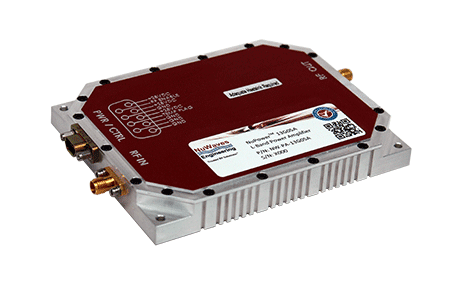The choice of RF Power Amplifier (PA) depends on the end-user’s application. The operating frequency range, output power, linearity, form-factor, and DC power consumption requirements help define the PA that is right for the application. In unmanned aircraft system (UAS) applications, form-factor and DC power consumption are critical – the smaller, lighter, and more efficient the PA, the greater the endurance of the UAS. For manned aircraft, land vehicles, or surface vessels, the performance characteristics of the PA are the deciding factors.
Before delving into the RF performance characteristics of the available PAs, one must determine if the PA should be bidirectional or unidirectional. If the radio used in the application transmits and receives on the same frequency, or uses a single RF output port for both transmit and receive, a bidirectional amplifier (BDA) is required. For radios that only transmit, or transmit and receive on different frequencies and have separate RF output/input ports for transmit and receive, a unidirectional PA will meet the system requirements. It should be noted that a BDA can be used in all of these scenarios; however, BDAs demand a higher cost and are typically larger in size and weight compared to a unidirectional PA.

Figure 1. The NuPower Xtender™ Bidirectional L- & S-Band Amplifier module is a small, broadband, high-performance RF amplifier covering the L- and S-band frequencies of 1.0 to 2.5 GHz.
The next PA features that will determine the suitability of the PA for the application are the linearity and efficiency. For radios that use constant-envelope waveforms – such as continuous-wave (CW), phase-shift keying (PSK), or frequency-shift keying (FSK) types – high linearity is not necessary. A non-linear or “saturated” PA has the advantage of being highly efficient, meaning more DC power is converted to RF energy instead of being wasted as heat – think of this as the incandescent light bulb vs. LED light: the same amount of light is produced, but the LED light consumes much less energy. Non-linear PAs also tend to be smaller in size than linear PAs, in large part due to the high-efficiency of the design. Further, by operating the PA in saturation, higher output powers are possible in the same package size as a linear PA.
For radios using high peak-to-average power ratio (PAPR) waveforms – such as orthogonal frequency-division multiplexing (OFDM), or quadrature amplitude modulation (QAM) types – high-linearity PAs are necessary for best performance. To achieve high-linearity, the output power of the PA is “backed-off,” such that the PA is operating in its linear region, not the saturated region as is the case with a non-linear PA. The downside to this is lower efficiency, as the PA consumes essentially the same amount of current as the non-linear PA, but the output power is reduced. The benefit however is a cleanly amplified signal that extends the range of the radio without sacrificing signal quality – leading to a lower bit-error-rate (BER) and higher data rates over greater distances.

Figure 2. The NuPower™ 13G05A L-Band Power Amplifier is a small, ultra-high-efficiency solid-state power amplifier module for CW operation that delivers, on average,50 watts of RF power from 800 MHz to 2 GHz.
NuWaves Engineering has developed a wide variety of off-the-shelf RF amplifiers with rich features to support mission-critical CONOPS in telemetry, ISR, and tactical communication systems applications. Frequency ranges are available from UHF through S-band (C-band coming soon!) with output power levels ranging from 5 to 50 W. All NuPower PAs are designed, built and tested in-house under NuWaves’ Quality Management System (QMS) certified to AS9100:2009 and ISO 9001-2008 standards, which ensures that each product arrives on-time and defect-free. Most models are in-stock. NuWaves also boasts a full suite of state-of-the-art design and simulation tools, test and measurement equipment, prototyping equipment and a full-scale production facility to provide custom solutions to your specifications. Contact NuWaves today to extend the range of your communications systems and don’t forget to check out our RF Power Amplifiers.



Comments are closed